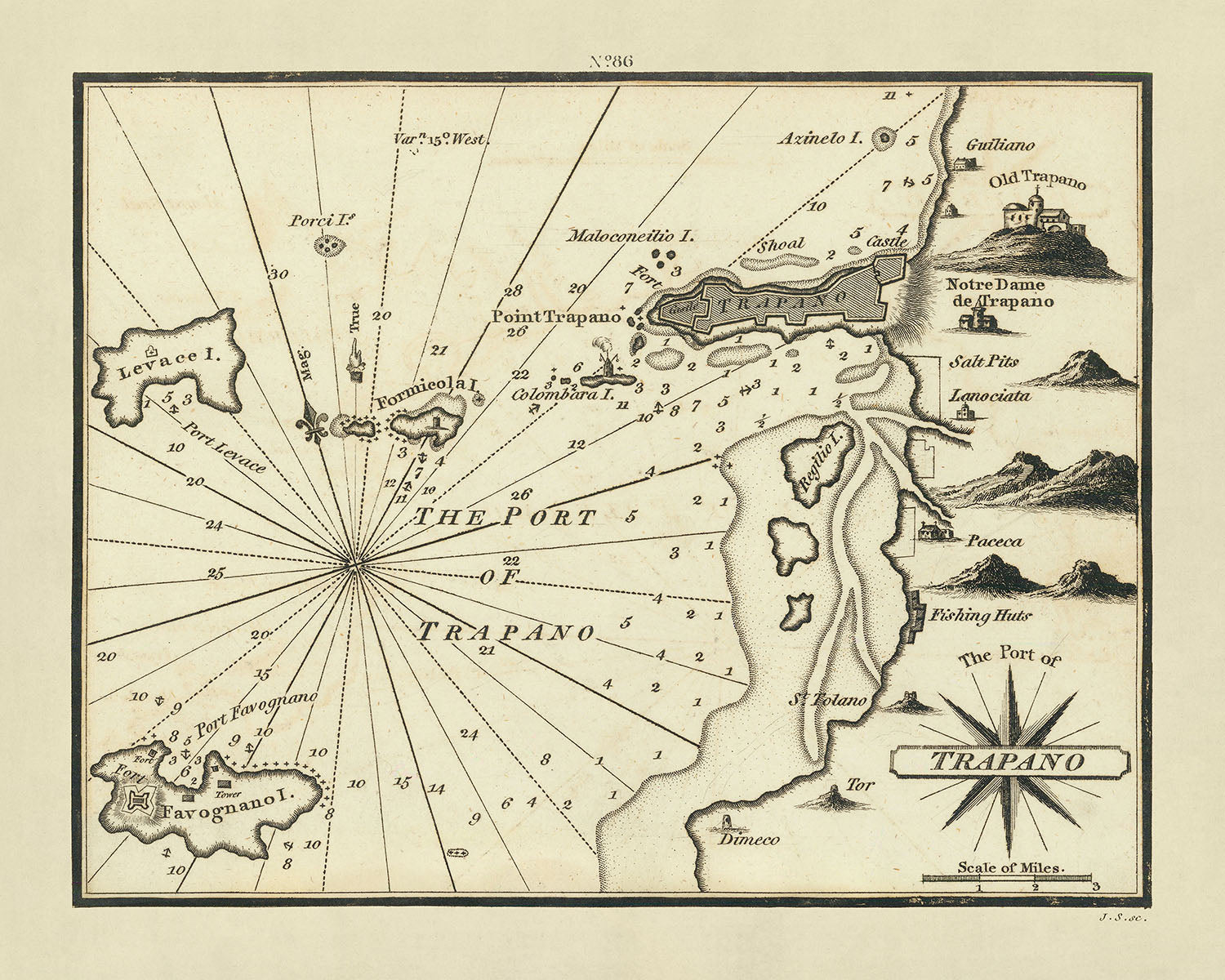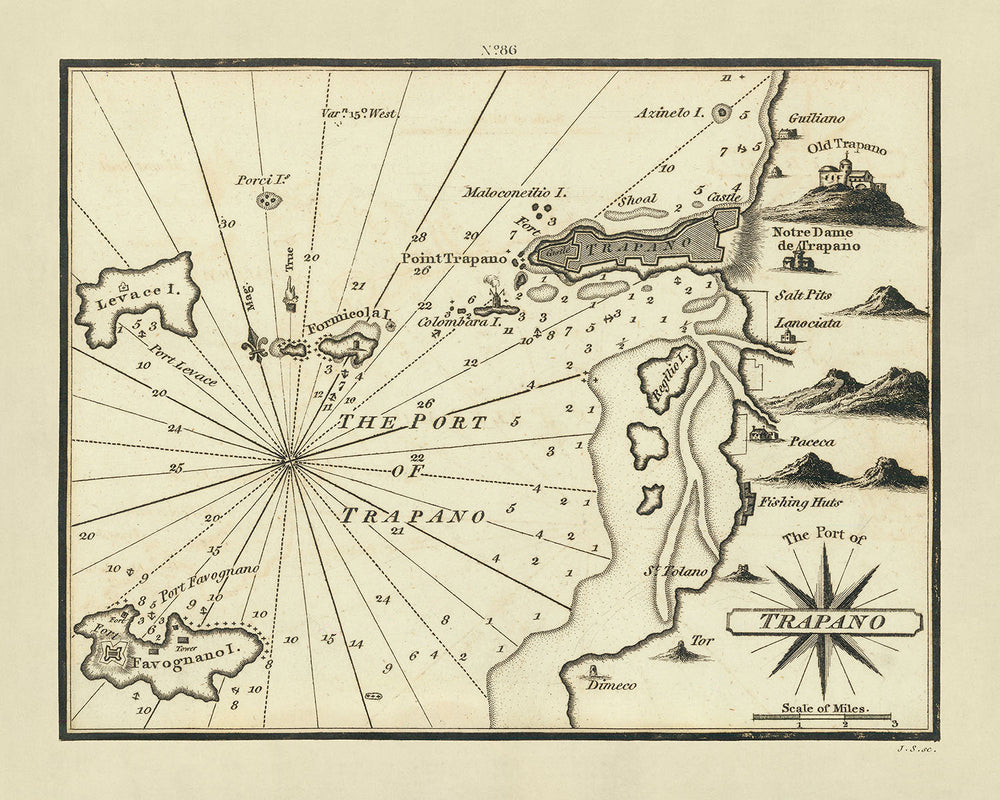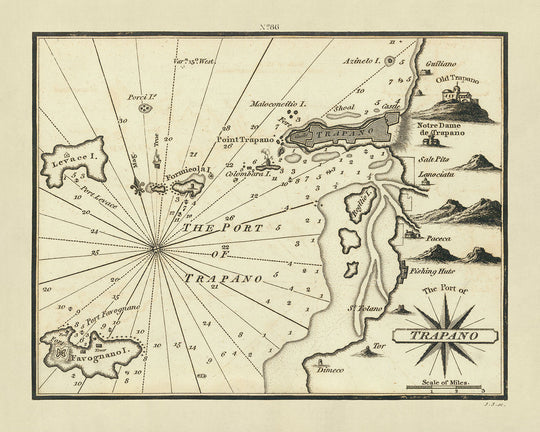- Handmade locally. No import duty or tax
- FREE Delivery by Christmas
- Love it or your money back (90 days)
- Questions? WhatsApp me any time
Own a piece of history
5,000+ 5 star reviews


The Port of Trapano: A Nautical Chronicle of 1802
The Port of Trapano, meticulously charted by William Heather in 1802, stands as a quintessential example of early 19th-century nautical cartography. This chart, a critical piece of Heather's The New Mediterranean Pilot, delineates the intricate details of the Sicilian coastline, focusing on the strategic port town of Trapani. Its significance is manifold; not only does it serve as a navigational aid, highlighting water depths, hazards, and landmarks, but it also encapsulates a snapshot of maritime life in the Mediterranean during a time of burgeoning English naval interest in the region. The chart's precision and detail reflect the heightened need for accurate maritime charts as English ships ventured more frequently into Mediterranean waters.
Intricate Details and Local Features
Heather's chart is far more than a simple guide; it is a rich tapestry of local geography and human activity. It meticulously marks the salt pits and fishing huts that were integral to Trapani's local economy, alongside the more monumental features such as the Torre di Ligny and the Lazzaretto di Trapani. Each of these features is not just a point on a map but a doorway into the daily lives of those who lived and worked in Trapani in the early 1800s. The inclusion of such details offers a vivid glimpse into the socio-economic conditions of the time, making this chart a valuable resource for both navigators and historians.
Artistry in Cartography
The aesthetic appeal of the chart cannot be overstated. Engraved by John Stephenson, a noted London engraver, the map is a work of art in its own right. Stephenson’s craftsmanship is evident in the finesse of the engraving, with each line and letter carefully rendered to produce a chart that is both functional and visually striking. This level of detail and artistic quality sets Heather's work apart from contemporary French and Italian nautical charts, which were often more utilitarian in design.
Historical and Navigational Significance
From a historical perspective, this chart is a rare artifact. As part of the first English collection of Mediterranean ports, it represents a significant moment in the history of cartography and naval exploration. The chart not only guided the mariners of its time but also helped establish English presence and trade routes in the Mediterranean, competing with the already established French, Italian, and Spanish charts. Its rarity and uniqueness add to its value, not just as a tool for navigation but as a collector's item and a piece of maritime history.
A Collector’s Jewel
For connoisseurs of cartography, maritime history, or simply lovers of rare historical documents, The Port of Trapano chart is an invaluable acquisition. It offers a window into the past, bringing to life the maritime routes that were once sailed by 19th-century navigators. Owning such a chart is akin to possessing a fragment of history, a narrative of adventures and endeavors on the high seas, captured forever in ink and paper by the skilled hands of William Heather and John Stephenson. This chart is not merely a map but a legacy of the age of sail, preserved through the meticulous art of cartography.
Notable Places on This Map
- Levace I.
- Port Levace
- Porci I.
- Mag
- True
- Var 15 West
- Malconeitio I.
- Fort
- Point Trapano
- Formicolal
- Colombara I.
- The Port of Trapano
- Port Favognano
- Tower
- Favognano I.
- Axinelo I.
- Guiliano
- Old Trapano
- Shoal
- Castle
- Notre Dame de Trapano
- Salt Pits
- Lanociata
- Paceca
- Fishing Huts
- Tor
- Dimeco
- Scale of Miles
Notable Features & Landmarks
- The coastline of Sicily and surrounding islands
- The town of Trapani and surrounding villages and towns
- The port of Trapani and surrounding fortifications
- Salt pits of Trapani
- Fishing huts of Trapani
- Torre di Ligny, a 16th-century watchtower
- Lazzaretto di Trapani, an 18th-century quarantine station
- Tonnara di Favignana, an 18th-century tuna trap
Historical and Design Context
- Title: The Port of Trapano
- Mapmaker/Publisher: William Heather
- Published: 1802 in London as part of Heather's The New Mediterranean Pilot
- Design/Style: Finely engraved chart, signed in monogram by London engraver John Stephenson
- Historical Significance: Rare example of an early English nautical chart of the Mediterranean Sea
- Themes: Nautical chart showing water depths, hazards to navigation, landmarks, and other navigational information
- Countries and Regions: Focus on the Mediterranean Sea, specifically Italy and Sicily
Please double check the images to make sure that a specific town or place is shown on this map. You can also get in touch and ask us to check the map for you.
This map looks great at every size, but I always recommend going for a larger size if you have space. That way you can easily make out all of the details.
This map looks amazing at sizes all the way up to 50in (125cm). If you are looking for a larger map, please get in touch.
The model in the listing images is holding the 16x20in (40x50cm) version of this map.
The fifth listing image shows an example of my map personalisation service.
If you’re looking for something slightly different, check out my collection of the best old maps to see if something else catches your eye.
Please contact me to check if a certain location, landmark or feature is shown on this map.
This would make a wonderful birthday, Christmas, Father's Day, work leaving, anniversary or housewarming gift for someone from the areas covered by this map.
This map is available as a giclée print on acid free archival matte paper, or you can buy it framed. The frame is a nice, simple black frame that suits most aesthetics. Please get in touch if you'd like a different frame colour or material. My frames are glazed with super-clear museum-grade acrylic (perspex/acrylite), which is significantly less reflective than glass, safer, and will always arrive in perfect condition.
This map is also available as a float framed canvas, sometimes known as a shadow gap framed canvas or canvas floater. The map is printed on artist's cotton canvas and then stretched over a handmade box frame. We then "float" the canvas inside a wooden frame, which is available in a range of colours (black, dark brown, oak, antique gold and white). This is a wonderful way to present a map without glazing in front. See some examples of float framed canvas maps and explore the differences between my different finishes.
For something truly unique, this map is also available in "Unique 3D", our trademarked process that dramatically transforms the map so that it has a wonderful sense of depth. We combine the original map with detailed topography and elevation data, so that mountains and the terrain really "pop". For more info and examples of 3D maps, check my Unique 3D page.
For most orders, delivery time is about 3 working days. Personalised and customised products take longer, as I have to do the personalisation and send it to you for approval, which usually takes 1 or 2 days.
Please note that very large framed orders usually take longer to make and deliver.
If you need your order to arrive by a certain date, please contact me before you order so that we can find the best way of making sure you get your order in time.
I print and frame maps and artwork in 23 countries around the world. This means your order will be made locally, which cuts down on delivery time and ensures that it won't be damaged during delivery. You'll never pay customs or import duty, and we'll put less CO2 into the air.
All of my maps and art prints are well packaged and sent in a rugged tube if unframed, or surrounded by foam if framed.
I try to send out all orders within 1 or 2 days of receiving your order, though some products (like face masks, mugs and tote bags) can take longer to make.
If you select Express Delivery at checkout your order we will prioritise your order and send it out by 1-day courier (Fedex, DHL, UPS, Parcelforce).
Next Day delivery is also available in some countries (US, UK, Singapore, UAE) but please try to order early in the day so that we can get it sent out on time.
My standard frame is a gallery style black ash hardwood frame. It is simple and quite modern looking. My standard frame is around 20mm (0.8in) wide.
I use super-clear acrylic (perspex/acrylite) for the frame glass. It's lighter and safer than glass - and it looks better, as the reflectivity is lower.
Six standard frame colours are available for free (black, dark brown, dark grey, oak, white and antique gold). Custom framing and mounting/matting is available if you're looking for something else.
Most maps, art and illustrations are also available as a framed canvas. We use matte (not shiny) cotton canvas, stretch it over a sustainably sourced box wood frame, and then 'float' the piece within a wood frame. The end result is quite beautiful, and there's no glazing to get in the way.
All frames are provided "ready to hang", with either a string or brackets on the back. Very large frames will have heavy duty hanging plates and/or a mounting baton. If you have any questions, please get in touch.
See some examples of my framed maps and framed canvas maps.
Alternatively, I can also supply old maps and artwork on canvas, foam board, cotton rag and other materials.
If you want to frame your map or artwork yourself, please read my size guide first.
My maps are extremely high quality reproductions of original maps.
I source original, rare maps from libraries, auction houses and private collections around the world, restore them at my London workshop, and then use specialist giclée inks and printers to create beautiful maps that look even better than the original.
My maps are printed on acid-free archival matte (not glossy) paper that feels very high quality and almost like card. In technical terms the paper weight/thickness is 10mil/200gsm. It's perfect for framing.
I print with Epson ultrachrome giclée UV fade resistant pigment inks - some of the best inks you can find.
I can also make maps on canvas, cotton rag and other exotic materials.
Learn more about The Unique Maps Co.
Map personalisation
If you're looking for the perfect anniversary or housewarming gift, I can personalise your map to make it truly unique. For example, I can add a short message, or highlight an important location, or add your family's coat of arms.
The options are almost infinite. Please see my map personalisation page for some wonderful examples of what's possible.
To order a personalised map, select "personalise your map" before adding it to your basket.
Get in touch if you're looking for more complex customisations and personalisations.
Map ageing
I have been asked hundreds of times over the years by customers if they could buy a map that looks even older.
Well, now you can, by selecting Aged before you add a map to your basket.
All the product photos you see on this page show the map in its Original form. This is what the map looks like today.
If you select Aged, I will age your map by hand, using a special and unique process developed through years of studying old maps, talking to researchers to understand the chemistry of aging paper, and of course... lots of practice!
If you're unsure, stick to the Original colour of the map. If you want something a bit darker and older looking, go for Aged.
If you are not happy with your order for any reason, contact me and I'll get it fixed ASAP, free of charge. Please see my returns and refund policy for more information.
I am very confident you will like your restored map or art print. I have been doing this since 1984. I'm a 5-star Etsy seller. I have sold tens of thousands of maps and art prints and have over 5,000 real 5-star reviews. My work has been featured in interior design magazines, on the BBC, and on the walls of dozens of 5-star hotels.
I use a unique process to restore maps and artwork that is massively time consuming and labour intensive. Hunting down the original maps and illustrations can take months. I use state of the art and eye-wateringly expensive technology to scan and restore them. As a result, I guarantee my maps and art prints are a cut above the rest. I stand by my products and will always make sure you're 100% happy with what you receive.
Almost all of my maps and art prints look amazing at large sizes (200cm, 6.5ft+) and I can frame and deliver them to you as well, via special oversized courier. Contact me to discuss your specific needs.
Or try searching for something!















































